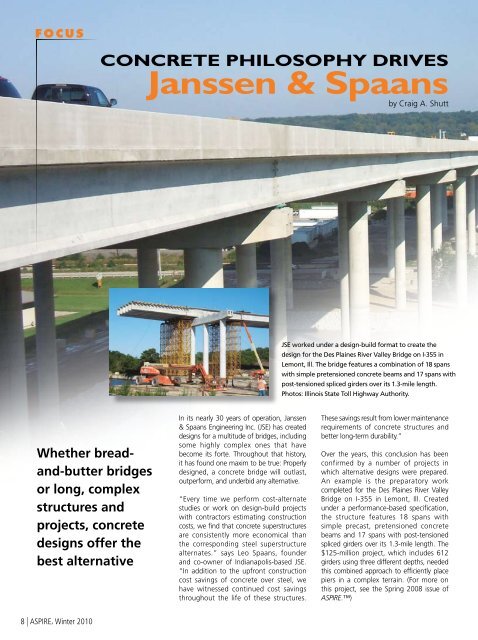ASPIRE Winter 10 - Aspire - The Concrete Bridge Magazine
ASPIRE Winter 10 - Aspire - The Concrete Bridge Magazine
ASPIRE Winter 10 - Aspire - The Concrete Bridge Magazine
Create successful ePaper yourself
Turn your PDF publications into a flip-book with our unique Google optimized e-Paper software.
FOCUS<br />
<strong>Concrete</strong> Philosophy Drives<br />
Janssen & Spaans<br />
by Craig A. Shutt<br />
JSE worked under a design-build format to create the<br />
design for the Des Plaines River Valley <strong>Bridge</strong> on I-355 in<br />
Lemont, Ill. <strong>The</strong> bridge features a combination of 18 spans<br />
with simple pretensioned concrete beams and 17 spans with<br />
post-tensioned spliced girders over its 1.3-mile length.<br />
Photos: Illinois State Toll Highway Authority.<br />
Whether breadand-butter<br />
bridges<br />
or long, complex<br />
structures and<br />
projects, concrete<br />
designs offer the<br />
best alternative<br />
In its nearly 30 years of operation, Janssen<br />
& Spaans Engineering Inc. (JSE) has created<br />
designs for a multitude of bridges, including<br />
some highly complex ones that have<br />
become its forte. Throughout that history,<br />
it has found one maxim to be true: Properly<br />
designed, a concrete bridge will outlast,<br />
outperform, and underbid any alternative.<br />
“Every time we perform cost-alternate<br />
studies or work on design-build projects<br />
with contractors estimating construction<br />
costs, we find that concrete superstructures<br />
are consistently more economical than<br />
the corresponding steel superstructure<br />
alternates.” says Leo Spaans, founder<br />
and co-owner of Indianapolis-based JSE.<br />
“In addition to the upfront construction<br />
cost savings of concrete over steel, we<br />
have witnessed continued cost savings<br />
throughout the life of these structures.<br />
<strong>The</strong>se savings result from lower maintenance<br />
requirements of concrete structures and<br />
better long-term durability.”<br />
Over the years, this conclusion has been<br />
confirmed by a number of projects in<br />
which alternative designs were prepared.<br />
An example is the preparatory work<br />
completed for the Des Plaines River Valley<br />
<strong>Bridge</strong> on I-355 in Lemont, Ill. Created<br />
under a performance-based specification,<br />
the structure features 18 spans with<br />
simple precast, pretensioned concrete<br />
beams and 17 spans with post-tensioned<br />
spliced girders over its 1.3-mile length. <strong>The</strong><br />
$125-million project, which includes 612<br />
girders using three different depths, needed<br />
this combined approach to efficiently place<br />
piers in a complex terrain. (For more on<br />
this project, see the Spring 2008 issue of<br />
<strong>ASPIRE</strong>.)<br />
8 | <strong>ASPIRE</strong>, <strong>Winter</strong> 20<strong>10</strong>

















